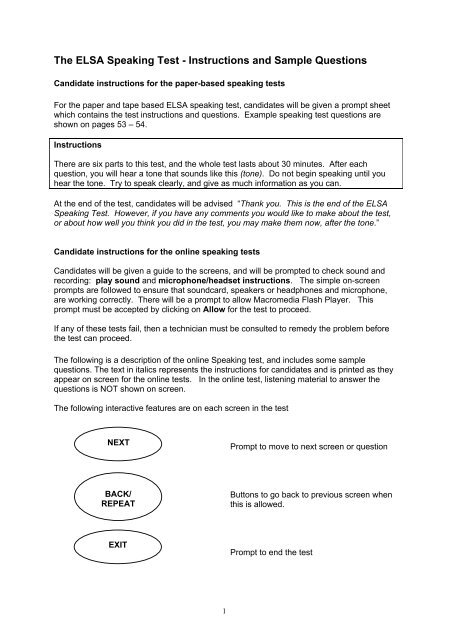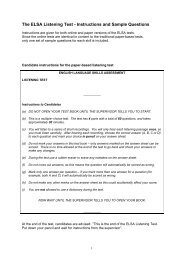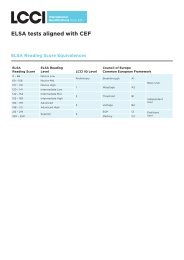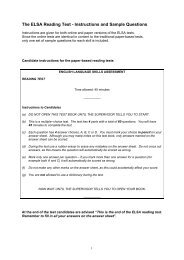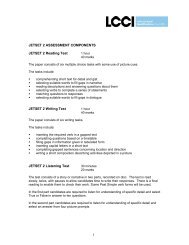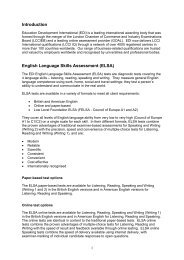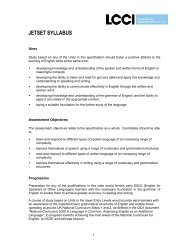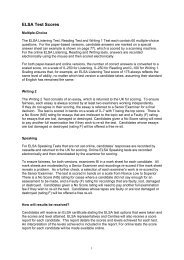The ELSA Speaking Test - Instructions and Sample Questions
The ELSA Speaking Test - Instructions and Sample Questions
The ELSA Speaking Test - Instructions and Sample Questions
Create successful ePaper yourself
Turn your PDF publications into a flip-book with our unique Google optimized e-Paper software.
<strong>The</strong> <strong>ELSA</strong> <strong>Speaking</strong> <strong>Test</strong> - <strong>Instructions</strong> <strong>and</strong> <strong>Sample</strong> <strong>Questions</strong><br />
C<strong>and</strong>idate instructions for the paper-based speaking tests<br />
For the paper <strong>and</strong> tape based <strong>ELSA</strong> speaking test, c<strong>and</strong>idates will be given a prompt sheet<br />
which contains the test instructions <strong>and</strong> questions. Example speaking test questions are<br />
shown on pages 53 – 54.<br />
<strong>Instructions</strong><br />
<strong>The</strong>re are six parts to this test, <strong>and</strong> the whole test lasts about 30 minutes. After each<br />
question, you will hear a tone that sounds like this (tone). Do not begin speaking until you<br />
hear the tone. Try to speak clearly, <strong>and</strong> give as much information as you can.<br />
At the end of the test, c<strong>and</strong>idates will be advised “Thank you. This is the end of the <strong>ELSA</strong><br />
<strong>Speaking</strong> <strong>Test</strong>. However, if you have any comments you would like to make about the test,<br />
or about how well you think you did in the test, you may make them now, after the tone.”<br />
C<strong>and</strong>idate instructions for the online speaking tests<br />
C<strong>and</strong>idates will be given a guide to the screens, <strong>and</strong> will be prompted to check sound <strong>and</strong><br />
recording: play sound <strong>and</strong> microphone/headset instructions. <strong>The</strong> simple on-screen<br />
prompts are followed to ensure that soundcard, speakers or headphones <strong>and</strong> microphone,<br />
are working correctly. <strong>The</strong>re will be a prompt to allow Macromedia Flash Player. This<br />
prompt must be accepted by clicking on Allow for the test to proceed.<br />
If any of these tests fail, then a technician must be consulted to remedy the problem before<br />
the test can proceed.<br />
<strong>The</strong> following is a description of the online <strong>Speaking</strong> test, <strong>and</strong> includes some sample<br />
questions. <strong>The</strong> text in italics represents the instructions for c<strong>and</strong>idates <strong>and</strong> is printed as they<br />
appear on screen for the online tests. In the online test, listening material to answer the<br />
questions is NOT shown on screen.<br />
<strong>The</strong> following interactive features are on each screen in the test<br />
NEXT<br />
Prompt to move to next screen or question<br />
BACK/<br />
REPEAT<br />
Buttons to go back to previous screen when<br />
this is allowed.<br />
EXIT<br />
Prompt to end the test<br />
1
<strong>The</strong> following screen includes the prompt to start the test.<br />
Up to this point it is possible to go back to the instructions <strong>and</strong> checking activities, if required.<br />
After the c<strong>and</strong>idate has clicked on START TEST it is NOT possible to go back to the<br />
earlier screens. Ensure c<strong>and</strong>idates underst<strong>and</strong> this. During the test, only screens<br />
giving examples may be repeated by clicking on the REPEAT button.<br />
<strong>The</strong> first part of the test is a warm up session with personal question, introduced by this<br />
screen.<br />
Note that the questions themselves do not appear on the screen. C<strong>and</strong>idates answer the<br />
question after the tone. <strong>The</strong>re is also a message saying<br />
RECORDING IN PROGRESS<br />
At the end of each <strong>Speaking</strong> test there will be a prompt to WAIT.<br />
Wait for the prompt that says TEST COMPLETE.<br />
This means the recordings from the test have been sent to EDI for scoring by an examiner.<br />
Click on the EXIT button to exit the test.<br />
2
<strong>Speaking</strong> test structure for both paper/tape <strong>and</strong> online versions<br />
Part 1 Introduction<br />
<strong>The</strong>re are four questions in this section. Answer each question after the tone. For<br />
example:<br />
How old are you? (tone)<br />
<strong>The</strong> second part of the test asks c<strong>and</strong>idates to repeat short sentences.<br />
Note that the sentences themselves do not appear on the screen. C<strong>and</strong>idates repeat the<br />
sentence question after the tone. <strong>The</strong>re is also a message saying<br />
RECORDING IN PROGRESS<br />
Part 2. Repetition<br />
In this section you will hear four short sentences. Repeat each sentence after the<br />
tone. For example:<br />
It’s a sunny day (tone)<br />
3
<strong>The</strong> third part of the test asks c<strong>and</strong>idates to respond as fully as possible to 12 short<br />
questions.<br />
Note that the questions do not appear on the screen. C<strong>and</strong>idates answer the question after<br />
the tone. <strong>The</strong>re is also a message saying<br />
RECORDING IN PROGRESS<br />
Part 3. Short answers.<br />
In this section you will hear twelve questions. You will have 15 seconds to answer<br />
each question as fully as possible. For example:<br />
When was the last time you went to the cinema? (tone)<br />
In the fourth part of the test c<strong>and</strong>idates are asked to answer questions by giving short<br />
descriptions. For questions 7 <strong>and</strong> 8 in this part a picture will appear on the lower screen.<br />
Note that the questions themselves do not appear on the screen. C<strong>and</strong>idates answer the<br />
question after the tone. <strong>The</strong>re is also a message saying<br />
RECORDING IN PROGRESS<br />
Part 4. Description.<br />
<strong>The</strong>re are eight tasks in this section – for number seven <strong>and</strong> eight you must describe a<br />
picture that will appear on screen. After the tone you will have 45 seconds to give<br />
your answer. Try to give as much detail as possible. For example:<br />
Describe the place where you work. (tone)<br />
4
In the fifth part of the test c<strong>and</strong>idates are asked to gibe their opinion on a variety of topics<br />
<strong>and</strong> have one minute to respond to each question.<br />
Note that the questions themselves do not appear on the screen. C<strong>and</strong>idates answer the<br />
question after the tone. <strong>The</strong>re is also a message saying<br />
RECORDING IN PROGRESS<br />
Part 5. Extended discourse.<br />
In this section there are five questions, asking for your opinion on a variety of topics.<br />
You will have one minute to give your opinion. <strong>The</strong>re is no example for this section.<br />
[C<strong>and</strong>idates listen to an example before starting the section]<br />
In the final part of the test c<strong>and</strong>idates are asked to tell a story based on pictures that will<br />
appear on screen. <strong>The</strong>re is no option to repeat the instructions on this screen.<br />
Note that the questions themselves do not appear on the screen. C<strong>and</strong>idates answer the<br />
question after the tone. <strong>The</strong>re is also a message saying<br />
RECORDING IN PROGRESS<br />
Part 6. Picture story.<br />
In this section you need to look at the 6 pictures on the screen. <strong>The</strong> pictures show a<br />
story. First you must answer one question about each picture. <strong>The</strong>n you must tell the<br />
whole story. Now you have 20 seconds to look at the pictures <strong>and</strong> decide what is<br />
happening in each picture.<br />
[C<strong>and</strong>idates listen to an example before starting the section]<br />
5
<strong>Speaking</strong> test sample questions<br />
<strong>The</strong> following are examples of the type of questions found on an <strong>ELSA</strong> <strong>Speaking</strong> <strong>Test</strong>. In the real test,<br />
the questions are NOT printed on the c<strong>and</strong>idate prompt sheet.<br />
Part 1 – Introduction<br />
Basic questions about personal details<br />
Part 2 – Repetition<br />
Example sentences:<br />
A I usually leave for work at 7.30<br />
B How much are those black shoes in the window?<br />
C Would you like to take a seat while you're waiting?<br />
D I can send someone to pick him up from the station if you'd prefer.<br />
Part 3 – Short answers<br />
A<br />
B<br />
C<br />
D<br />
E<br />
E<br />
F<br />
How often do you buy a newspaper?<br />
When was the last time you played any sport?<br />
What kind of films do you like?<br />
What happens to ice if it is left in the sun?<br />
(British) What would you do if you accidentally spilled coffee on a colleague's expensive clothes?<br />
(American) What would you do if you accidentally spilled coffee on a coworker’s expensive<br />
clothes?<br />
What are the most important characteristics of a good nurse?<br />
Part 4 – Description<br />
A Describe what you are wearing on your feet<br />
B Describe a book<br />
C Describe a desk<br />
D What is a mirror? Describe what it looks like, <strong>and</strong> what it can be used for.<br />
E Describe how you would take a photograph of someone.<br />
Picture description: see pictures A <strong>and</strong> B shown below<br />
Part 5 – Extended discourse<br />
A<br />
What do we mean by recycling? Give examples of objects which can or should be recycled <strong>and</strong><br />
explain why recycling is important. What difficulties st<strong>and</strong> in the way of recycling <strong>and</strong> how might<br />
these difficulties be overcome? (American only, British English spelling would be "programmes",<br />
though this material is not printed in the real test)<br />
6
B<br />
Nowadays, we are getting more <strong>and</strong> more television channels, satellite <strong>and</strong> terrestrial. Some<br />
people say this is leading to a drop in the quality of the programs that are being shown. Do you<br />
agree that more necessarily means worse? Give reasons for your opinion.<br />
Part 6 – Picture story (see pictures 1-6 below)<br />
1 Why did Mike yawn when he woke up?<br />
2 What was he doing at 7.50?<br />
3 How did Mike spend his day?<br />
4 What did he do on the way home?<br />
5 Why was he so pleased?<br />
6 How did he celebrate his win?<br />
Story<br />
Look at Pictures 1–6 on the picture above <strong>and</strong> tell the story. Give as much detail as possible <strong>and</strong> try<br />
to make the story as interesting as you can.<br />
Part 7 – C<strong>and</strong>idate Comments<br />
C<strong>and</strong>idates may make any comments they wish about the test or how well they think they did. This<br />
section is not normally treated as part of the test for scoring purposes.<br />
7


